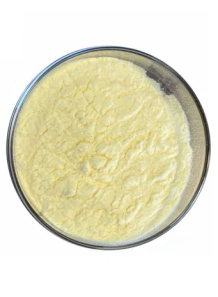Pure-Rutin™ (Rutin from Sophora japonica)
- Product Code: 8719
a natural citrus bioflavonoid, is extracted from the dry buds of sophora japonical. Rutin is a phenolic antioxidant and has been demonstrated to scavenge superoxide radicals. Rutin can chelate metal ions, such as iron, thereby reducing the Fenton reaction (production of damaging oxygen radicals). Rutin is classified as vitamin P which increases the strength of the walls of the blood capillaries and regulates their permeability
a natural citrus bioflavonoid, is extracted from the dry buds of sophora japonical. Rutin is a phenolic antioxidant and has been demonstrated to scavenge superoxide radicals. Rutin can chelate metal ions, such as iron, thereby reducing the Fenton reaction (production of damaging oxygen radicals). Rutin is classified as vitamin P which increases the strength of the walls of the blood capillaries and regulates their permeability
Rutin, a natural citrus bioflavonoid, is extracted from the dry buds of sophora japonical. Rutin is a phenolic antioxidant and has been demonstrated to scavenge superoxide radicals. Rutin can chelate metal ions, such as iron, thereby reducing the Fenton reaction (production of damaging oxygen radicals). Rutin is classified as vitamin P which increases the strength of the walls of the blood capillaries and regulates their permeability.
Please find more detail about research in the attached file
Here is a summary of the key findings and numerical data:
Study Overview and Methods:
-
In Vitro Studies on HDFs:
- Cell Viability and Cytotoxicity: Rutin was tested on HDFs at concentrations ranging from 0 to 200 µM. At 50 µM, rutin reduced cell viability by 13.23%, and at 100 µM, it reduced viability by 26.05%. Concentrations higher than 100 µM showed increased cytotoxicity.
- Oxidative Stress Protection: Cells pre-treated with rutin (0-100 µM) for 3 hours and then exposed to 0.2 mM H2O2 for 24 hours demonstrated increased protection against oxidative stress.
- Reactive Oxygen Species (ROS) Scavenging Activity: Rutin stimulated ROS scavenging activity in a dose-dependent manner. The fluorescence intensity decreased as rutin concentration increased, indicating reduced ROS levels in treated cells.
- Gene Expression: Rutin increased mRNA expression of collagen type I, alpha 1 (COL1A1), and decreased mRNA expression of matrix metallopeptidase 1 (MMP1), which are indicators of enhanced skin structural integrity and reduced degradation.
-
In Vivo Studies on Human Skin:
- Clinical Study Design: A double-blind clinical study involved 40 women aged 30-50, divided into a control group and an experimental group. The experimental group used a cream containing 2% rutin for 4 weeks.
- Dermal Density and Skin Elasticity: Measurements were taken before application, after 2 weeks, and after 4 weeks. The results showed significant improvements in dermal density and skin elasticity in the experimental group compared to the control.
- Wrinkle Reduction: The length, area, and number of crow's feet and under-eye wrinkles were measured. There was a notable decrease in wrinkle length and area after 2 and 4 weeks in the group using the rutin-containing cream.
Scientific Results and Numerical Data:
-
Dermal Density and Elasticity:
- Increase in Skin Elasticity: The study used Young's modulus (E) to quantify changes in skin elasticity. The experimental group showed a statistically significant increase in elasticity (p < 0.05) after 4 weeks of rutin application.
- Improvement in Dermal Density: Measured using a DUB SkinScanner, dermal density increased significantly in the rutin group after 4 weeks compared to the baseline (p < 0.05).
-
Wrinkle Metrics:
- Crow’s Feet Reduction: The length of crow’s feet decreased by approximately 5.7% after 2 weeks and 9.3% after 4 weeks.
- Reduction in Wrinkle Area: The area of under-eye wrinkles was reduced by about 7.2% after 2 weeks and 12.5% after 4 weeks.
-
Gene Expression Data:
- COL1A1 mRNA: Expression levels increased by 1.7-fold in HDFs treated with rutin, suggesting enhanced collagen production.
- MMP1 mRNA: Expression levels decreased by 0.6-fold, indicating a reduction in collagen breakdown.
Use: Can be used in all types of Anti-aging products.
Mixing method: Mix in the last part. Avoid heat above 40C
Usage rate: 0.1-3%
Product characteristics: Light green-yellow powder
Solubility: Can dissolve in water
Storage: For long term storage Store at room temperature Do not expose to sunlight, heat, seal the lid tightly, shelf life at least 2 years
INCI Name : Rutin
Example products:
StriVectin Present Perfect Antioxidant Defense Lotion
Yves Rocher Crema Facial Hidratante Calmante
StriVectin SD Advanced™ PLUS Intensive Moisturizing Concentrate
| Mechanism | - |
| Appearance | - |
| Longevity | - |
| Strength | - |
| Storage | - |
| Shelf Life | - |
| Allergen(s) | - |
| Dosage (Range) | - |
| Recommended Dosage | - |
| Dosage (Per Day) | - |
| Recommended Dosage (Per Day) | - |
| Mix Method | - |
| Heat Resistance | - |
| Stable in pH range | - |
| Solubility | - |
| Product Types | - |
| INCI | - |
Purchase History for
Cart
No products



